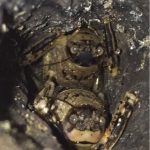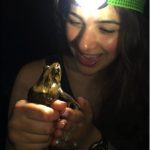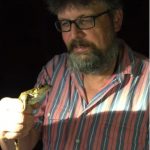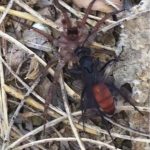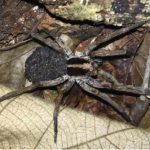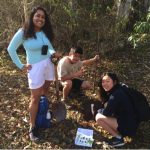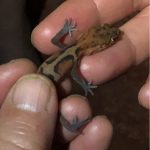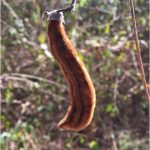Sunday morning began bright and early at 5:00am for the students’ first day of research for their final papers. The students had woken up from their first sleep in their hammocks after Jesus had taught them the night before how to sleep in them properly; by tying a knot on one side to create a wall, then laying down diagonally to distribute the weight. Unfortunately, students still needed a bit more practice as they got twisted, turned, and quite cold during the night. Although tired, the students were grateful for the experience of being completely immersed in such a unique lifestyle.
Each of the 6 groups spread out across the Kaxil Kiuic seasonal dry forest to find inspiration for a potential hypothesis. As the groups headed out, they were also tasked with coming up with a group name. The majority of group names were inspired by their own potential hypothesis. Groups ‘Funguys’ and ‘Holy Moly Guacamoley’ set out together finding various water holes inside of trees as well as 2 crickets huddled inside of a narrow hollowed tree trunk. Both of these groups took observational data on the organisms and microclimates found. Meanwhile, ‘The Hoots (Hooters)’ group, saw many birds species, including 3 turkey vultures, laughing falcons, and a social group of Yucatán Jays (bright blue), which are endemic to the Yucatán Peninsula. The group decided that their hypothesis would involve ferruginous pygmy owls, saw-wet owls, and northern cardinals to determine song birds’ and hummingbirds’ reactions to each call, and whether they can differentiate between a locally common species, an owl from another part of the world, and a ‘control’ bird call of a non-predatory species. At the same time, the groups ‘2 girls 1 guy’ and the ‘Rolling Stones (now renamed The Beetles)’ set out west to go to the watering hole (‘aguada’). The students found a wasps’ nest and photographed it. Unfortunately, one student took too long to take photos and was stung on the lip. For the rest of the day, the students referred to him as the 8th Kardashian-Jenner from his swollen bottom and ‘pouty’ lip. The final group the ‘Burning Wood Babes’ equipped themselves with a shovel and the moisture metre when they headed out and immediately begun taking measurements of the soil.
The groups reconvened at 8:00am for their first breakfast. The students had the options of Fruit Loops, Nesquick, and Honey Bunches of Oats cereals as well as a variety of fresh fruits and juice. After breakfast the students reunited with the professors to discuss their ideas for a hypothesis and how to test them. Prof. Lougheed challenged each group to ask “Who cares and why is this important?” regarding their work, to familiarize the students with the notion of providing the most relevant context that might be useful for a publication in scientific journal. A common theme of importance, for example, was that water is a valuable commodity and a species’ ability to successfully survive in the dry season is an interested an relevant focus of research. We also talked about plant competition, and the concept of allelopathy (where a tree species might exude a chemical into the soils that precludes or at least limits growth of other plant species).
The students then set out once more in their groups to gather data and refine their experimental designs (group ‘The Beetles’ creating an arena and gathered beetles) now that their hypothesis had been assessed by their peers and the professors..
For dinner the students feasted on the delicious tamales cooked by Rosario and Wilvia. While the students gathered to prepare for their night walk, Thomas found a Yucatán gecko. Once everyone arrived, Prof. Lougheed discussed his first trip to Africa, the challenges that he faced, how he made his lesson plans, and the joys of learning in the field. The students then headed out to go to the watering hole. On their way there, Dr. Lougheed caught a black scorpion that students had spotted on a tree. Upon arrival at the watering hole, Prof. Lougheed also caught a Rio Grande leopard frog after students had seen it poking out from the water. The frog was dubbed Hipolito and the students learnt about the vast array of mating and parenting strategies in amphibians. For example, in one frog species (the tailed frogs of Western North America) males use their tails as an intromitant organ to ensure that his sperm is successfully transferred into the cloacas of females in their fact flowing aquatic environments. Amphibians generally have the second broadest array mating systems in the world of vertebrates, after fish, in terms of parental care and reproduction. Some species (e.g. plethodont salamanders) are direct developing, where eggs are laid terrestrially and all development occurs within. Glass frog females may deposit their eggs on a leaf above water, where they can hatch and drop into water beneath. If a snake predator approaches, however, larvae can ‘hatch’ early to escape predation.
Just beyond the watering hole, the students found a wolf spider underneath a large rock with her egg sac. To prevent injury to the spider, the students had to scare it away when the rock was put back in its place as well as to prevent habitat disturbance. Soon after, another wolf spider was found by its reflective eyes in the dark, however this spider’s babies were on the mothers back. Sadly, Jesus informed the students that the mother was going to be soon eaten by the spiderlings. The students then headed back to the classroom to finish off the day with three seminars on global climate change and its potential influence on species and habitat distributions, the closing of the Isthmus of Panama and its influence on Neotropical and Nearctic flora and fauna, and the avifauna of Campeche, southern Mexico.
Español
Iniciamos el Domíngo temprano pero listos para nuestro primer día de investigación requerida para nuestro reporte final. Despertamos de nuestra primera noche de dormir en hamacas después de la lección que nos dió Jesús de como dormir en ellas la noche anterior. Se tiene que amarrar priemro de un extremo con nudos bien atados, luego se tiene que acostar uno de manera diagonal para distribuir el peso. La lección no fue suficiente pues la mayoría no podiamos acomodarnos, dabamos vueltas y pasamos algo de frio por la noche. Aunque amanecimos cansados estabamos emocionados por la vivir esta experiencia única y el estilo de vida del lugar.
Cada uno de los seis equipos nos fuimos a explorar la selva de la reserva de Kaxil-Kiuic para inspirarnos en la búsqueda de ideas y proponer hipótesis para nuestro proyecto. Mientras exploramos, discutimos también cuál sería un buen nombre para nuestro equipo. La mayoría de los nombre de equipos fueron inspirados con relación al enfoque del proyecto. Nombres como Los Funguys (Hongos divertidos), “Holy Moly Guacamoley” encontratron varios hoyos con agua en la base de árboles y revisando cavidades encontraron unos grillos refugiados dentro de una de ellas. Los dos equipos describieron los micro-habitats y especularon sobre el microclima en las cavidades. Por otro lado el equipo de los “Hooters” (Tecolotes) observaron la saves, incluyendo tres zopilotes, Halcón selvatico, y una bandada de Charas Yucatecas de colores azúl y negr brillante, endémicas de la Península de Yucatán. El equipo decidió su hipótesis sobre la respuesta de aves a un depredor (el Tecolotito tropical pigmeo) comparando respuestas contra otros estimulos externos, incluyendo el Tecolote Aegolius acadicus y un Cardenal como control. Por otro lado, los equipos llamados “Dos chicas y un Chico” y los renombrados “Escarabajos” fueron a otro lado a buscar una aguada. Encontraron un nido de avispas que fotografiaron. Uno de los estudiantes tardó tomando fotos y una avispa lo picó justo en el labio. Por el resto del día los demás le llamamos el 8vo Jenner-Kardashian debido a su labio hinchado muy sexi. El ultimo equipo Las chicas incendiarias, equipadas con pala y equipo de medición de humedad, se lanzaron a muestrear el suelo.
Poco despues, nos reunimos a las 8:00am para nuetro desayuno de frutas y jugo, así como cereal de varios tipos. Después del desayuno nos reunimos con los profesores para discutir nuestros avances, ideas e hipótesis y como demostrarlas. El Dr. Lougheed nos planteó la pregunta ¿Porqúe es importante? para conocer la justificación de la investigación y el proceso de preparación y revisión de artículos científicos. Nos centramos en el ejemplo de como el agua es un recurso muy limitado y sobre la capacidad de lase species de poder sobrevivir al periodo de secas. También discutimos sobre la interacción entre plantas relacionada con alelopatía.
Una vez que terminamos, regresamos al trabajo de campo para obtener más datos y trabajar más con nuestros diseños experimentales. El equipo de los Escarabajos una vez aprobada su hipótesis construyeron una arena para su experimento sobre la selección de habitat.
Para la hora de la cena comimos unos deliciosos tamales hechos por Rosario y Wilvia. Después nos fuimos a una caminata nocturna; poco después encontramos un Gecko Yucateco muy bonito. Al regresar nos reunimos para platicar y el Dr. Lougheed nos compartió sobre su primer curso en Africa, los sacrificios que pasó en ese tiempo y la forma de preparer su material de clases en campo. Nos fuimos a caminar a la aguada, en el camino Jesús capturó un escorpión que un estudiante descubrió en un tronco. Cuando llegamos a la aguada el Dr. Lougheed capturó una rana leopard después de que uno de los estudiantes la vió saltando al agua. La llamamos “Hipólito” y aprendimos sobre su sistema de fertilización externa. Esta rana usa su abrazo prensil para asegurar que el semen entre a la cloaca de la hembra. Estas ranas tienen un sistema reproductive muy complejo con respecto a otros vertebrados, incluyendo el cuidado parental. Alguans especies se desarrollan sin cuidado parental, eclosionando y realizando la metamosfósis en poco tiempo. Otras especies depositan sus huevos en tierra y todo el desarrollo se dá dentro del huevo. En otras especies, como la rana de cristal, los huevos se depositan bajo las hojas y pueden eclossionar de inmediato bajo la presión de un depredador como serpientes que se aproximan.
En otro lugar cercano a la aguada, otro estudiante encontró una araña lobo bajo una roca y tenía su saco de huevos. Para no lastimarla, los estudiantes la ahuyentaron cuando regresaron la roca a su lugar y disminuir afectación al microhabitat. Así encontramos muchas más arañas, incluyendo algunas arañas mamas con crías en sus espaldas. Jesús nos contó que tristemente los bebes se comerían a su madre como una primera fueste de proteína. Regresamos al campamento para terminar el día con tres seminaries más, incluyendo cambio climático, El Puente del Itsmo de Panamá y sobre la avifauna de Campeche.
